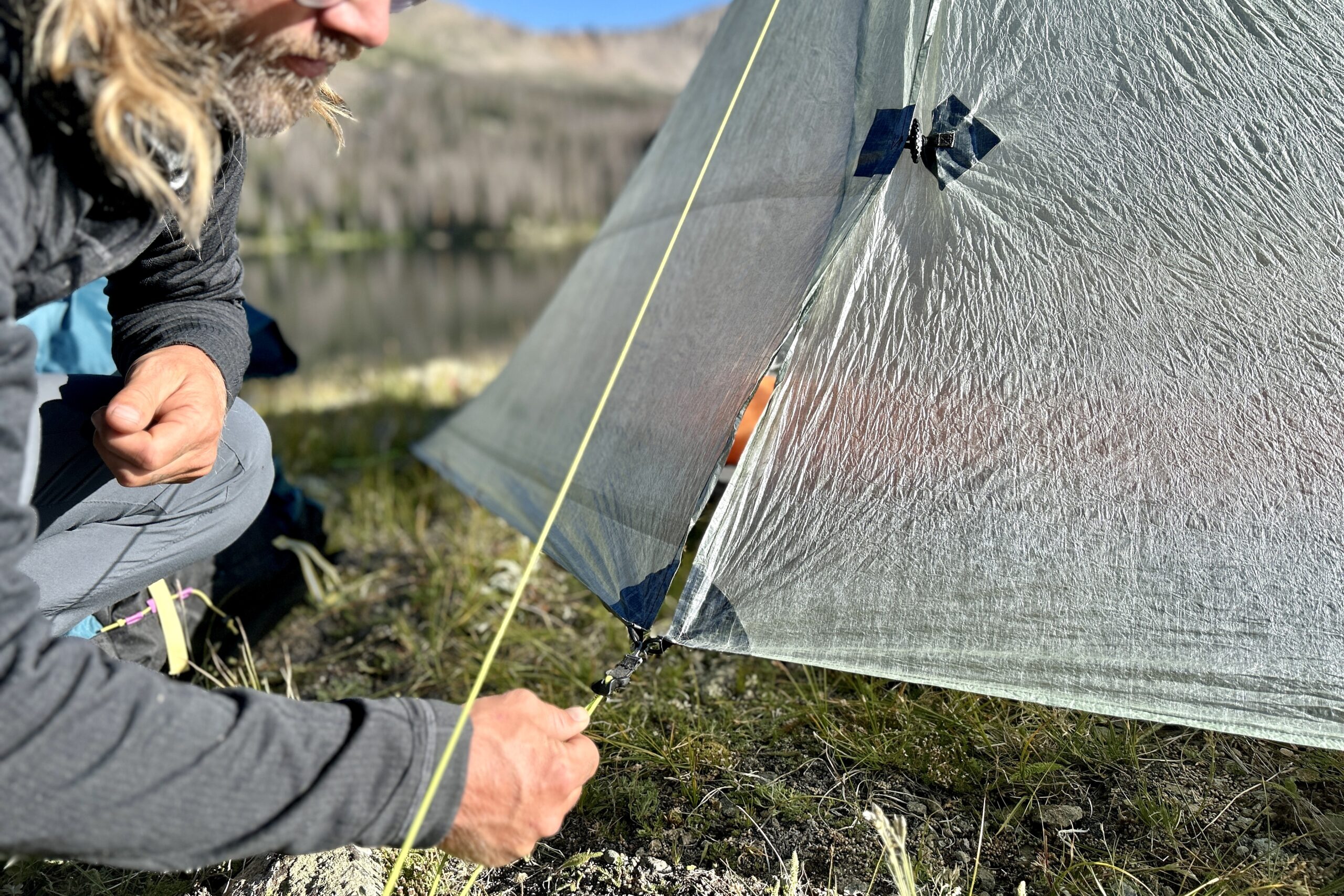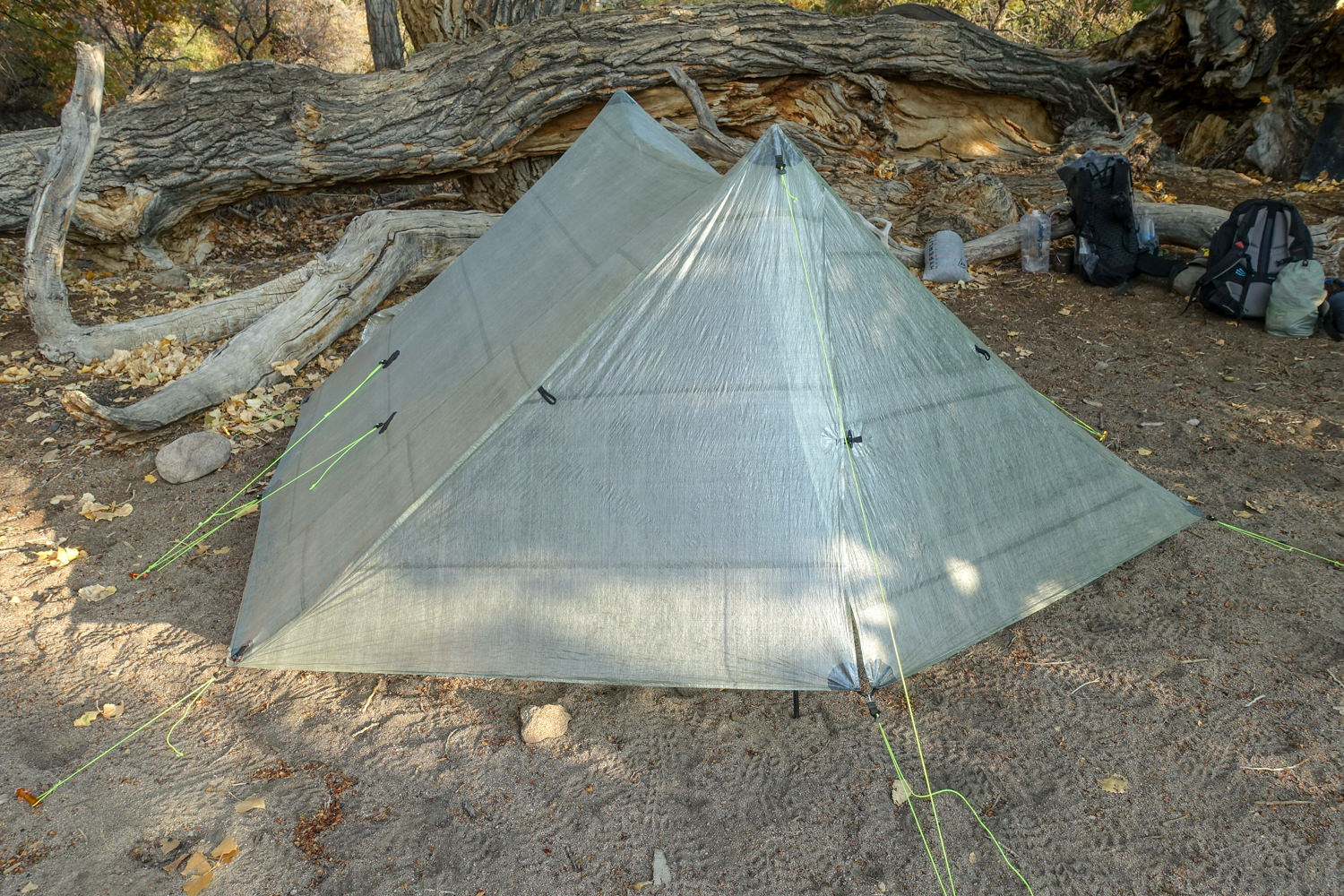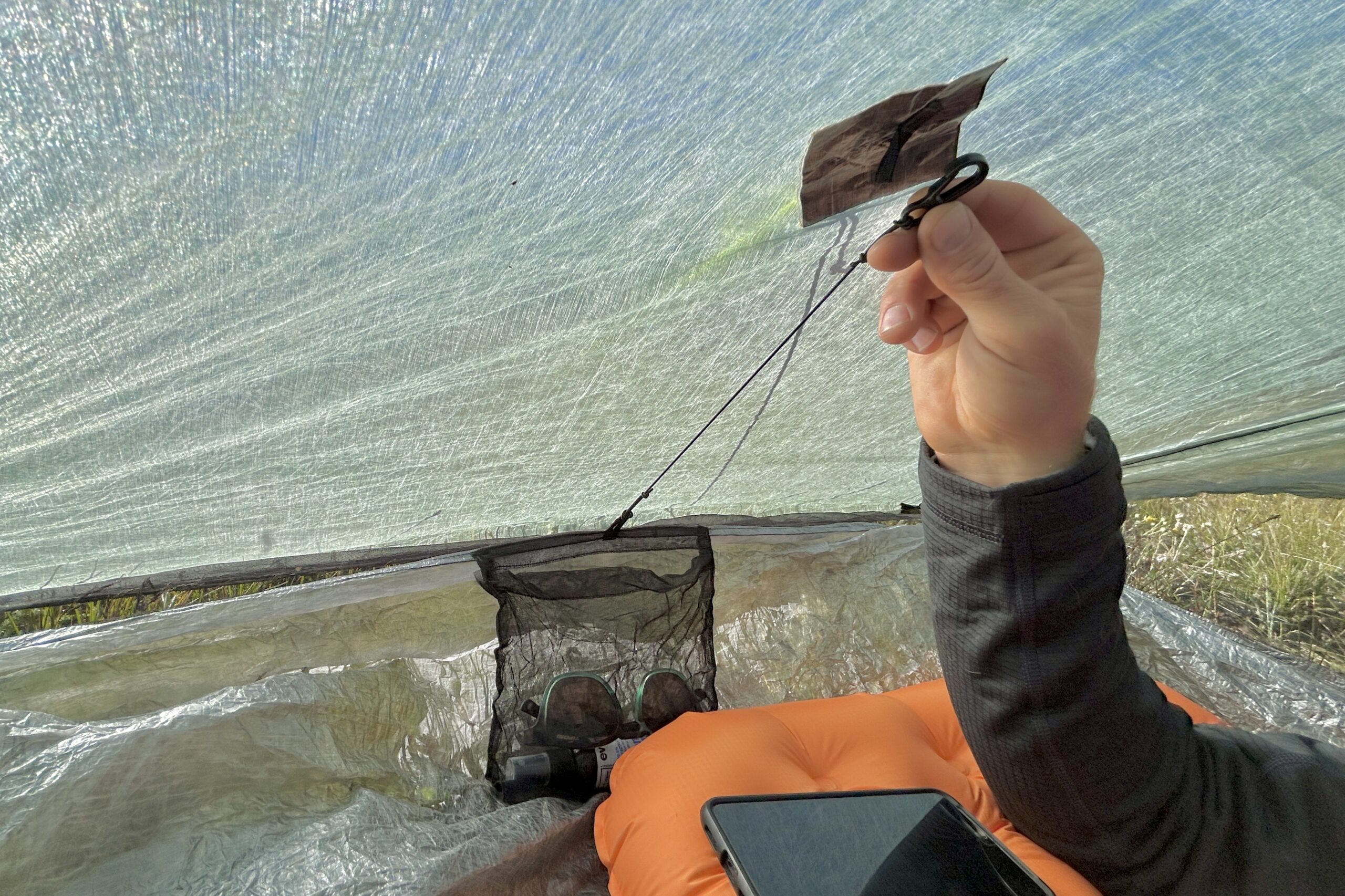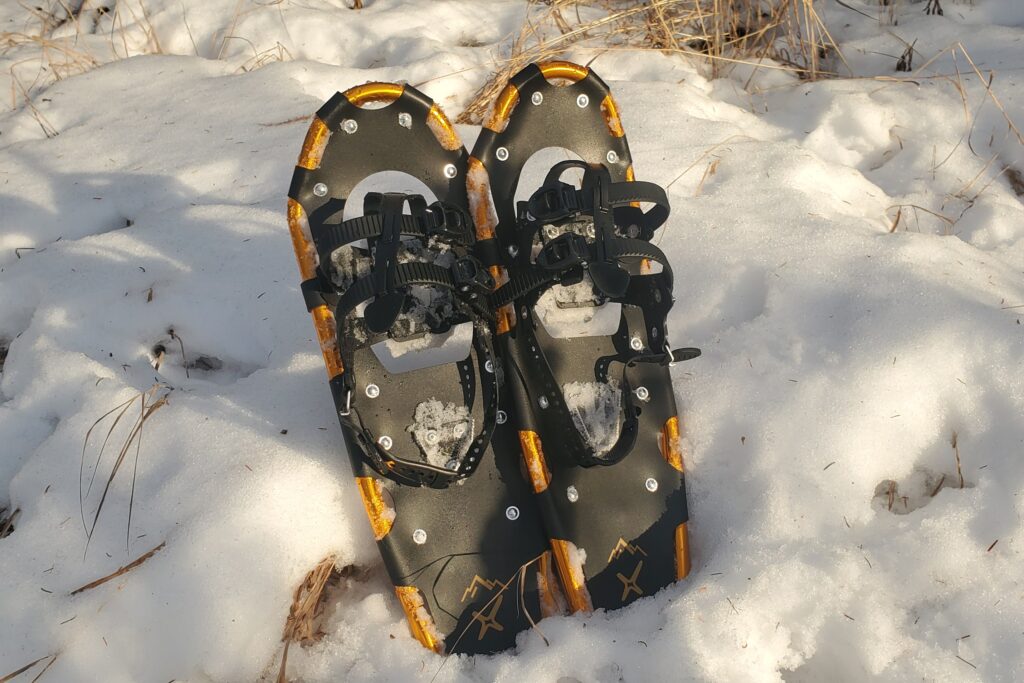
Bottom Line
The Zpacks Duplex is the gold standard of ultralight backpacking shelters. Thanks to a spacious design, impressive weather resistance, and extremely low weight, it’s been one of our go-to tents over hundreds of nights on trail, including months-long thru hikes across rugged mountains and brambly deserts. That’s why the Duplex has been one of the top picks on our best ultralight tents list and best backpacking tents list for years.
Ideal for challenging terrain, high-elevation ascents, and demanding 20+ mile days, the Duplex is an excellent investment for ultralight and lightweight backpackers. As with any tent, it requires certain tradeoffs – it’s expensive, can be challenging to pitch, and isn’t the most durable – but the smart, efficient design sets it apart.

Zpacks Duplex Classic
Best Ultralight Backpacking Tent
CleverHiker Rating: 80/100
Price: $699
Packed Weight: 1 lb. 1.9 oz.(no stakes or poles)
Dimensions (LxWxH): 90 x 45 x 48 in.
Type: Non-freestanding
Pros
- Ultralight
- Very durable for the weight
- Spacious
- Ample headroom
- DCF material won’t sag when wet
- Large doors/vestibules
- Trekking poles can double as tent poles
Cons
- Expensive
- Needs condensation management
- Non-freestanding design has a learning curve

Comfort
The Zpacks Duplex offers impressive comfort for an ultralight tent, and that mostly comes down to the awesome amount of livable interior space. The 28.1 square foot floor area offers plenty of room for two people, including 7.5 feet to stretch out from end to end and a 48-inch peak height to sit up and move around comfortably. At 45 inches wide, you can fit one wide sleeping pad and one standard sleeping pad easily, although two wide pads would be tight. We’ve spent many backcountry nights sharing the Duplex with a hiking partner and found it manageable for two people. However, if you’re regularly hiking with another person, we recommend sizing up to the Triplex for the extra room. Or, if you’re over 6 feet tall, consider the XL version for more headroom and length.
The vestibules are an average size but offer plenty of space to keep a pair of shoes and a backpack out of the rain, and they’re set a bit higher than other tents to keep the air flow and minimize condensation. We also appreciate the expansive half-moon-shaped mesh doors because of their generous size and accessibility. Because the interior doors open down and rest on the ground, there’s no need for tiebacks. We’ve found the doors make access to all of your gear fast and easy, and the zippers are effortless to open and close with one hand if needed.
But, as with all ultralight gear, the Duplex is designed for a streamlined and efficient setup – not luxurious, and extended stays. Our biggest gripe is the lack of interior storage: there are only two pockets in the Duplex, but they are small and thin. They’re fine for lightweight items like a lighter or chapstick, but nothing heavier, although you can add another small pocket for more storage (and an additional fee).
The sloping walls create a lightweight structure, but they bring the tent fabric closer to your face, which can feel claustrophobic for some folks. The vestibules are functional, but aren’t as spacious as other backpacking tents, which can limit the gear storage options for two campers. And it’s worth noting not everyone will love that the mesh doors are designed to lay on the floor of the tent when it’s open, which can lead to dirty and damaged mesh. However, we have never found this to be a significant issue. In our experience, the mesh tends not to get in the way when entering and exiting the tent and lasts a long time.

Weight & Packed Size
Zpacks’ Duplex is the definition of ultralight, making it one of the lightest tents in the world. At only 1 pound, 2.5 ounces, the Duplex forgoes heavy materials, zippers, and poles, making it multiple times lighter than freestanding or semi-freestanding competitors. Zpacks uses ultralight and waterproof Dyneema Composite Fabric (DCF) to save weight, and it shaves more ounces since it’s pitched with only two vertical poles. You can set it up with trekking poles, which is ideal if you’re hiking with them anyway, or opt for Zpacks’ ultralight 2.6-ounce carbon fiber tent poles. Not every trek requires such a minimal shelter, but the Duplex is a great choice for weight-conscious adventurers tackling tough mountainous terrain, long-distance trails, and thru-hikes.
The downside of DCF is it doesn’t pack down as small as polyester or nylon. The packed size of a standard Duplex is six inches in diameter by 12 inches long, with a stuff sack that’s seven inches in diameter by 13 inches long. In general, we recommend folding and rolling your Duplex, since stuffing can weaken the material over time, and also contributes to a larger packed size. That said, the packed size is a minor inconvenience for us and we don’t think it would be a dealbreaker for most people, but the Duplex will definitely take up more room in your backpack than an ultralight nylon tent.

Weather Resistance
The Duplex offers outstanding weather protection, from light summer storms to massive, blustery downpours. Its bathtub floor is waterproof and runs several inches up the walls to prevent splashback. The rest of the interior tent is mesh to maximize ventilation. The rainfly and tent floor are constructed from Dyneema Composite Fabric (DCF), a highly waterproof material that doesn’t sag or stretch in cold or wet conditions. The overlapping rainfly doors use hooks instead of zippers to minimize snagging and enhance the tent’s resilience in wind and rain. The high placement of the vestibules is unusual, but this design improves ventilation and reduces condensation. Even in blustery storms, the Duplex has kept us dry, with rainwater running off and away from the tent efficiently.
However, the Duplex’s design makes it a bit fussier than freestanding tents when weather is moving in. The non-freestanding design means that proper staking and guylines are crucial to keep the tent stable in strong winds and heavy rain. For example, if the ground is particularly hard or rocky, securing the tent can be a real challenge, and you may need to use rocks or logs to hold stakes in place. The slower setup of the Duplex is also it’s downfall, since you’ll spend more time setting up the tent just right in the weather before you can get out of it. The high vestibules are excellent for ventilation, but it also leaves a gap where wind-driven rain enters if it’s not perfectly angled. The overlapping rainfly doors are practical but require extra care in high winds to keep them secure.

Ease of Setup
The Duplex, like all non-freestanding tents, can take some tinkering to perfect your pitch. Since the tent uses a minimum of six load-bearing stakes, the Duplex takes up more space than most freestanding tents. That means campsite selection can take longer to find the ideal flat, open, wide, and obstruction-free area. Then, once it’s pitched, the Duplex requires attention to detail: you’ll need to resituate tent stakes and fiddle with cinch cords until the tent is taut and as functional as possible.
In our experience, the finagling and effort it takes to nail the pitch on the Duplex can take two to three times longer to set up than a freestanding tent but might take more time based on conditions. For example, pitching the tent is more difficult if the ground is hard and stakes aren’t going in easily, you’re limited to a narrow space, or have to contend with lots of obstacles like roots or rocks.
We’ve found the learning curve to pitching the Duplex is relatively short for most people, but you’ll want to practice at home before your first few trips. We recommend pitching the tent multiple times in varied terrain and conditions. Getting familiar with the challenges of setting up on slanted, rocky, or tight places is essential for thriving with the Duplex – and will save you time and frustration in the backcountry.
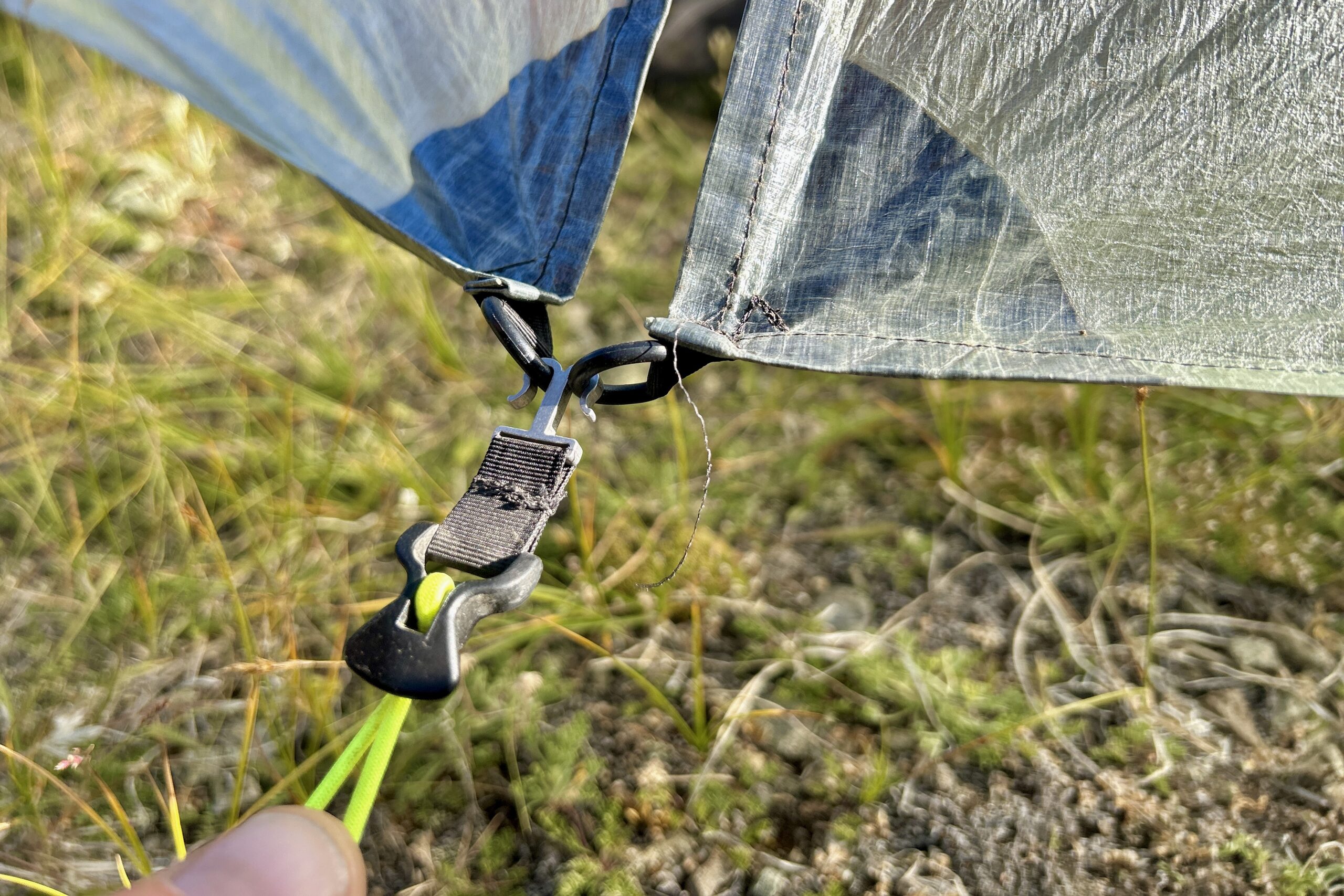
Durability
The DCF fabric is reliable in all weather and dries quickly. With care and attention, the Duplex is built to last whether you’re a thru-hiker or a weekend warrior. DCF is why the Duplex remains taut and secure, even in heavy rain.
Unlike nylon, DCF does not stretch, so it’s more susceptible to punctures. That means the Duplex isn’t as durable against abrasion as tents made with thicker ripstop materials. Luckily, the material patches well. When you buy the Duplex, Zpacks includes a piece of repair tape, but we highly recommend bringing along a durable patch option like Tenacious Tape to handle rips. Since DCF doesn’t have a waterproof coating like nylon, the patches are less likely to peel and more likely to stay attached to fabric better. And, in case you need it, Zpacks offers a 2-year limited warranty as well as a highly-reviewed repair program for damaged products.
Like any tent, we recommend choosing a campsite carefully and taking the time to clear away debris like rocks and twigs to prevent damage. Consider purchasing a DCF groundsheet or a Tyvek groundsheet to give the tent floor more protection. For more tips on how to extend the life of your tent, see our guide How to Clean, Repair, and Store Your Tent.

Should You Buy the Zpacks Duplex?
If you’re an ultralight backpackers who doesn’t want to compromise between featherlight gear and bombproof weather protection, the Zpacks Duplex is a dream come true. It’s perfect for those who heading on any sized trip – from long thru-hikes to weekend trips – where every ounce matters. The tent’s spacious interior, lightweight materials, and simple design makes it a top choice for anyone needing reliable shelter in diverse environments, from dry deserts to wet, mountainous terrain. It’s especially well-suited for solo adventurers or couples who want a ton of space without carrying the extra weight of a larger tent.
However, the Duplex is not for everyone. It’s very expensive, which might deter casual campers or those new to backpacking. Additionally, the non-freestanding design and learning curve for setup can be challenging for those who prefer a more straightforward tent experience. If durability or ease of use is a priority over weight, other tents might better suit your needs.

What Other Backpacking Tents Should You Consider?
Big Agnes Tiger Wall UL2 Review: The Big Agnes Tiger Wall UL2 also prioritizes weight savings and packability, making it a favorite among ultralight backpackers. It has a semi-freestanding design that is more intuitive to pitch and is a bit wider than the Duplex. This model also offers a more UV-resistant fly.
Durston X-Mid 2: Like the Duplex, the Durston X-Mid 2 is another non-freestanding tent that offers a similarly huge interior, minimalist features, and two doors. However, it’s less than half the price, is a bit larger, and offers even better storm resistance, although it weighs a bit more.
MSR FreeLite 2 Review: The MSR FreeLite 2 is also built for long-distance hikers who want a lightweight and compact shelter in the backcountry. Unlike the Duplex, though, the FreeLite 2 is more affordable and durable, although twice the weight. It’s a semi-freestanding design that’s faster and more straightforward to pitch.





